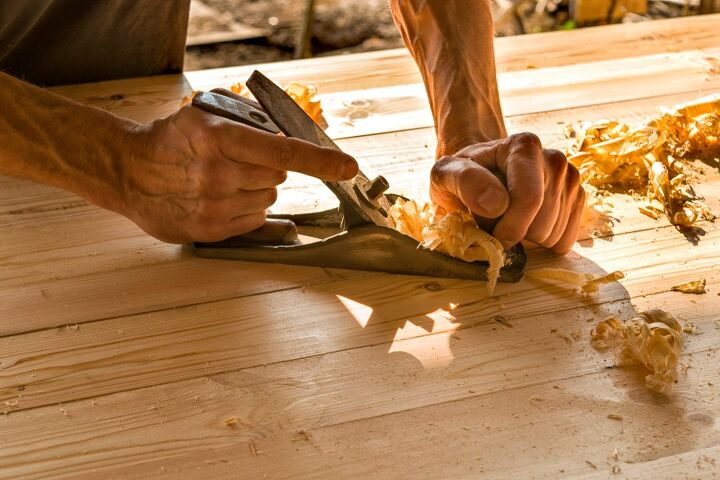Hand Planer Vs. Sander: What Are The Major Differences?

Raise your hand if you’ve ever used the wrong tool for a job? Once, my brother tried to unscrew something that wasn’t even a screw… Knowing which tool is right for the task makes the project run much more smoothly.
And speaking of smoothly, we’re here to talk about the difference between a hand planer and a sander. On the surface (pun intended), they may seem interchangeable. However, they have two different purposes.
A sander is used to remove surface wood. Its main purpose is to remove or alter the top layer of wood and smooth any imperfections. It’s considered a finishing tool. A hand planer is used to even out the thickness of a piece of wood. A planer also smoothes the wood, but it levels the thickness at the same time.
Do You Need to Hire a Framing Contractor?
Get free, zero-commitment quotes from pro contractors near you.

What is a Hand Planer?
For a woodworking project that requires a level surface, you would use a planer. With each pass, they remove slivers of wood until the surface is even.
A hand planer differs from an electric planer or a power planer. Unlike their stationary counterparts, hand planers are designed—as its name suggests—to fit in your hand. They are portable and allow the user more mobility. Check out the 5 best belt grinder kits to get the job done.
How Do They Work?
After presetting a level of thickness on the planer, a rotating cutter head removes any uneven spots on the wood until the whole board is level.
When to Use One
Depending on the nature of the project, a hand Planer may be the better tool. A hand planer is best used for the following:
- Smaller pieces that need extra attention
- Parallel surfaces like window frames, tables, or doors
- When making symmetrical sloping planes
- When making radius cuts
Keep in mind that you cannot sand concrete with regular sandpaper.
What is a Sander?
While a planer removes many layers of wood, a sander really only removes the surface layer. Sanders should be thought of as finishing tools. They work much slower than planers, only removing tiny amounts of wood at a time.
A sander can be used to level wood, though it’s not the best use of the tool. Because of how little wood is removed when sanding, using it to level wood can be costly and time-consuming. You’ll need to make multiple passes in order to make any sort of dent. This causes a lot of heat build-up in the sander, burning the sandpaper, blowing a fuse, or burning the wood.
The longer you run the sander the more times you’ll have to replace the sandpaper. This cost can add up over the course of the project.
Belt and Orbital Sanders
Two of the most popular types of electric sanders are the belt sander and the orbital sander.
On a belt sander, a loop of sandpaper runs constantly like a conveyer belt. It is very powerful and perfect for large pieces of wood.
An orbital sander has sandpaper discs that move in a circular motion. While both options are handheld, an orbital sander is better for smaller projects like furniture because the user has more control.
When to Use One
Different sanders are used for different parts of the woodworking process. A belt sander would be used first to remove the roughest layer of wood, prepping it for other sanders. Depending on the project, you may need an orbital sander next to remove more roughness with more control than you’d have with a belt sander. After that, you can continue using the orbital sander to finish or change to another type of finishing sander.
Pros and Cons of a Hand Planer
While a hand planer has many benefits, it also has some disadvantages. However, if it’s right the right tool for the project, the cons may be unavoidable.
Pro: Straight and Uniform.
With a planer, it’s easier to get a straight and even cut with every pass. Because of its design, it doesn’t take as much concentration to create an even surface.
Con: Messy.
Hand planers don’t often come with dust bags or anything to catch the debris. This can leave your work area quite messy.
Pro: Smooth, Even Finish.
Sometimes with a belt sander, you can still experience grittiness on the surface of the wood. At the end of every pass, planers leave the wood smooth and even without needing to sand it.
Con: Not THAT Smooth.
A planer only gets the smoothness of the wood to a certain point. Using a finishing sander will ensure an even smoother surface.
Pro: Cost Effective.
Purchasing a planer is a one-time investment. Occasionally, you’ll need to sharper and replace the blades. With a power sander of any kind, you constantly have to replace the sandpaper. And depending on the type of sander, that can be costly.
Pros and Cons of a Belt Sander
Belt sanders are powerful tools, but sometimes, that power comes at a price.
Pro: Quick and Efficient.
They allow you to tackle big jobs much faster because of their power.
Con: Difficult to Handle.
While their power is a benefit, it can also be a bad thing, especially for beginners. You have to pay close attention to understand how much material is being removed in one pass.
Pro: Large Surface Area.
The larger the surface area on your belt sander the more surface you can cover on the wood. Using a belt sander with a large surface area improves your chances of not having to go over the same spot twice. A large surface area is also easier to handle.
Con: Aggressive.
It’s possible for a belt sander to remove too much surface area if you’re not careful. You never want to use a belt sander for detailing because it’s much too aggressive. It’s solely to remove imperfections in the wood.
Pro: Teaches Skills.
Because of how difficult it is to handle a belt sander, there is a learning curve when using one. It sort of forces you to concentrate and learn the importance of balancing tools.
Pros and Cons of an Orbital Sander
Orbital sanders are wonderful tools that every woodworker has in their toolbox. But they also have their downfalls.
Pro: Powerful.
Though not as powerful as a belt sander, orbital sanders can still remove rough surface layers of wood.
Con: Expensive.
Orbital sanders tend to be more expensive than other handheld sanders. Many people still consider the expense worth it for the amount of power they produce.
Pro: Versatile.
Orbital sanders can be controlled and manipulated for different types of sanding needs. By applying less pressure and changing to finer grit sandpaper, orbital sanders can be used for finishing work.
Con: No Tight Corners
Because of how they are designed, orbital sanders can reach tight corners or 90-degree angles.
Pro: Dust Collector.
The paper and sanding pad is designed with tiny holes that whisk the dust away as it sands. So, you’re not left with a high pile of sawdust!
Related Questions
Now that we know what jobs work best for a hand planer and a sander, you may still have more questions. Below are things other people wondered about planers and sanders.
Can you use a planer to remove old finish?In theory, you can use a planer to remove old finish, but it would not be the best use of the tool. Certain finishes, such as polyurethane, can be softened by friction from a planer. In that case, the finish may gum up the planer’s knives. A belt sander would be a much better tool for this purpose.
Do you have to sand after using a Planer?You aren’t required to sand after using a planer, especially if you’re satisfied with the smoothness of the surface. Sanding will simply smooth the surface even further.
What sander is best for removing paint?Either an orbital sander or a belt sander would work to remove paint. The belt sander would be a better choice for removing many layers of paint or for larger-scale projects. It will get the job done faster. An orbital sander would work when removing paint from a smaller surface area.
In what direction should a belt sander be used?
The action in sanding should be linear. You always want to sand with the grain, not against it. Keep your pressure and pace as even as possible.
Do You Need to Hire a Framing Contractor?
Get free, zero-commitment quotes from pro contractors near you.

Final Thoughts
There’s a proper tool for every job, and woodworking is no different. Choosing between a hand planer and a sander ultimately comes down to the type of job you want to do.
A hand planer works best for creating a uniformly smooth and level surface. It does this by removing larger chunks of wood with each pass. You have the option to leave the wood as is or sand the surface some more after using a planer.
A sander, whether orbital or belt, removes imperfections on the surface of the wood. Because it’s typically the last step in smoothing the surface of the wood, it should be considered a finishing tool. While a sander can be used to level wood, it’s not the most effective way to use the tool.

Brigid Levi is a wife, mother, and freelance writer who enjoys a good DIY project and creating beautiful spaces within her home. From cleaning and organization hacks to home decor ideas, she loves helping people in their quest to turn a house into a home. Her hobbies include pretending to be Joanna Gaines while updating her home with her husband and performing in local theater productions.
More by Brigid Levi



























